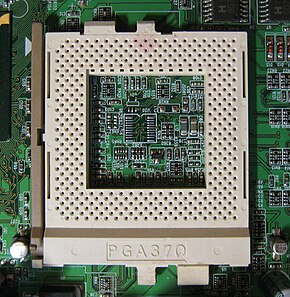Socket 370
 |
|
| Type | PGA-ZIF |
|---|---|
| Chip form factors | Plastic pin grid array (PPGA) and Flip-chip pin grid array (FC-PGA and FC-PGA2) |
| Contacts | 370 |
| FSB protocol | GTL+ |
| FSB frequency | 66, 100 and 133 MHz |
| Voltage range | 1.05–2.1 V |
| Processor dimensions | 1.95 × 1.95 inches |
| Processors |
Intel Celeron Mendocino (PPGA, 300–533 MHz, 2.0 V) |
|
This article is part of the CPU socket series |
|
Intel Celeron Mendocino (PPGA, 300–533 MHz, 2.0 V)
Intel Celeron Coppermine (FC-PGA, 533–1100 MHz, 1.5–1.75 V)
Intel Celeron Tualatin (FC-PGA2, 900–1400 MHz, 1.475–1.5 V)
Intel Pentium III Coppermine (FC-PGA, 500–1133 MHz, 1.6–1.75 V)
Intel Pentium III Tualatin (FC-PGA2, 1000–1400 MHz, 1.45–1.5 V)
Socket 370 (also known as the PGA370 socket) is a common format of CPU socket first used by Intel for Pentium III and Celeron processors to replace the older Slot 1 CPU interface on personal computers. The "370" refers to the number of pin holes in the socket for CPU pins. Modern Socket 370 fittings are usually found on Mini-ITX motherboards and embedded systems.
Socket 370 was originally used for the Intel Celeron, but later became the socket/platform for the Coppermine and Tualatin Pentium III processors, as well as the Via-Cyrix Cyrix III, later renamed the VIA C3. Some motherboards that used Socket 370 support Intel processors in dual CPU configurations. Others allowed the use of a Socket 370 or Slot 1 CPU, although not at the same time.
The weight of a Socket 370 CPU cooler should not exceed 180 grams (6.3 ounces). Heavier coolers may result in damage to the die when the system is not properly handled.
Most Intel Socket 370 processors (Pentium III and Celeron) have the following mechanical maximum load limits which should not be exceeded during heat sink assembly, shipping conditions, or standard use. Load above those limits will crack the processor die and make it unusable.
...
Wikipedia
